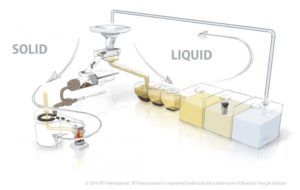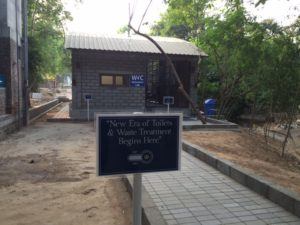Sustainable Toilets: A Pleasant Solution to a Foul Problem

As climate change and resulting droughts threaten the world’s water supply, can we afford to keep flushing our problems away? Nonprofit RTI International has developed an incinerator toilet—entirely self-sustaining in energy efficiency—that will revolutionize water use in human waste disposal. http://abettertoilet.org/
Whoooooosssshhhhhh! Humans around the world use toilets six to eight times per day, accompanied by the familiar sound of the water flush.[1] Since 40% of the world’s population remains without access to toilets, international attention on sanitation problems, hence the upcoming United Nations Water World Toilet Day on November 19.[2] However, a new challenge has emerged: as climate change and resulting droughts threaten the world’s water supply, can we afford to keep flushing our problems away? Nonprofit RTI International has developed an incinerator toilet—entirely self-sustaining in energy efficiency—that will revolutionize water use in human waste disposal.[3]
The world’s most terrifying problem is climate change. Water stress in lower mid-altitude arid and semi-arid regions, caused by climate change-stimulated droughts, is among climate change’s most pressing problems.[4] The southwestern United States faces massive water shortages despite large and growing populations, presenting an intractable quandary.[5] Should fresh water supplies be transported from elsewhere—and further drain already strained reservoirs in other locations—or should desalination be used to convert seawater, but destroying oceanic ecosystems in the process?[6], [7] Both options are extraordinarily energy and capital intensive, requiring immense upfront investment. The optimal choice is unclear, but one conclusion follows: humans must find new ways to use less water.
Empowered by a research grant from the Bill and Melinda Gates Foundation, RTI International sees opportunity in adapting to water scarcity. RTI’s toilet requires no electricity, water, or sewer connection.[8] It works by mechanically separating solid and liquid waste and burning solid waste using a combustion unit.[9] Thermal energy produced by combustion is then used to disinfect liquid waste using electrochemical treatment.[10] As of October 2016, RTI is beta testing a prototype toilet in India.[11]
Figure 1. The sustainable RTI incinerator toilet.
Figure 2. The RTI prototype in Ahmedabad, Gujarat, India.
Incinerator toilets offer significant advantages over alternative options for sustainable toilets. For example, no-flush toilets lead to sludge in sewer systems and bad odors. [12] Although they also require no water or electricity, they are largely limited to urinals. Freezing toilets require electricity, which limits sustainability.
Considering billions of toilets exist worldwide, even at high unit price, the Total Available Market for incinerator toilets is massive. Over 4 billion people use toilets every day, resulting in as much as 51.2 billion gallons of water used daily by toilets.[13] Today, RTI’s incinerator toilet can be operated for less than $0.05/day in India, which is less than the approximately $0.08/day low-flush toilets currently cost in the U.S.[14], [15] However, incinerator toilets are costly relative to existing toilets—which have still not reached the entire world population—limiting the Serviceable Available Market and Serviceable Obtainable Market (SOM).
In order to address challenges associated with converting research prototypes to mass market products, RTI must focus on four tasks following successful development. First, RTI must reduce unit cost in order to maximize SOM; much future market growth is in developing economies, and the longevity of toilet product life has led to low replacement rates. Second, RTI must find manufacturing partners who can produce the toilet, including in or near international markets currently or imminently facing water scarcity, and develop a supply chain that can both meet demand and sustainably source materials. As a nonprofit, like IKEA, RTI can utilize net income to fund sales growth and further sustainability research. Third, RTI must market and sell the toilet aggressively worldwide, including by partnering with the United Nations and nongovernmental organizations already working to raise climate change and sustainability awareness. Lastly, in order to gain a toehold in the market, RTI must lobby for government, tax, and regulatory changes to incentivize incinerator toilet installation. RTI toilets offer a complete solution to a real problem, and the world must invest now or confront impossible costs later.
(800 words)
[1] World Toilet Organization, http://worldtoilet.org/, accessed November 2016.
[2] Ibid.
[3] RTI International, “Reinventing the Toilet,” http://abettertoilet.org/, accessed November 2016.
[4] World Economic Forum, Climate Adaptation in 2014: Seizing the Challenge, p. 25, http://www3.weforum.org/docs/GAC/2014/WEF_GAC_ClimateChange_AdaptationSeizingChallenge_Report_2014.pdf, accessed November 2016.
[5] U.S. Environmental Protection Agency, “A Closer Look: Temperature and Drought in the Southwest,” https://www.epa.gov/climate-indicators/southwest, accessed November 2016.
[6] Scientific American, “The Impacts of Relying on Desalination for Water,” https://www.scientificamerican.com/article/the-impacts-of-relying-on-desalination/, accessed November 2016.
[7] Roman Kilisek, “Climate Change, Desalination and the Water-Food-Energy Nexus,” Breaking Energy, January 24, 2014, http://breakingenergy.com/2014/01/24/climate-change-desalination-and-the-water-food-energy-nexus/, accessed November 2016.
[8] RTI International, supra note 3.
[9] Ibid.
[10] Ibid.
[11] Lauren K. Ohnesorge, “RTI Opens Indian Subsidiary, Tackles Toilets, Cancer,” Triangle Business Journal, February 24, 2016, http://www.bizjournals.com/triangle/blog/techflash/2015/02/rti-international-opens-indian-subsidiary-rtp.html, accessed November 2016.
[12] Phil Matier & Andy Ross, “Low-Flow Toilets Cause a Stink in SF,” San Francisco Gate, February 28, 2011, http://www.sfgate.com/bayarea/matier-ross/article/Low-flow-toilets-cause-a-stink-in-SF-2457645.php, accessed November 2016.
[13] Estimate assumes approximately eight daily flushes per person. Since low-flush toilets use under 1.6 gallons/flush and are now common worldwide, the 1.6 gpf figure was used to be conservative.
[14] Ohnesorge, supra note 12.
[15] Fairfax County Water Association, “Is Water Free?”, https://www.fcwa.org/story_of_water/html/costs.htm, accessed November 2016.





Hi Phil,
This is amazing! From a public health perspective, there are massive costs to the alternative to effective toilets in the developing world (i.e. increased risk of contaminating river and ground water supplies with human fecal matter which increases risks of transmission of bacterial, viral and parasitic infections on a community scale. One question for you – what exactly happens to the solid or liquid waste from the toilet? Regarding the solid waste, I know you mentioned that they are incinerating this waste. Is there a way to convert the solid waste into a useful product with minimal energy use in the toilet? In other words, can we turn it into safe fertilizer pellets that can be used or sold? Is there a way to convert the liquid waste into potable water? If they’re able to turn the products of human waste into products with commercial value this would be a very easy way to incentivize broad adoption!
Taki
Taki, to your question on can the solid waste be used to create a byproduct, there is a company called Sanergy based out of Kenya that has built it’s business model around this idea. http://saner.gy/our-work/the-sanergy-model . To help commercialize and make their portable toilets affordable, they collect the waste using franchise partners and then convert it in a centralized facility into organic fertilizer, insect-based animal feed, and renewable energy. A really clever way to tackle the issues of impact, scale, and cost.
While an interesting solution, this toilet prototype seems like a long-shot to widespread adoption. The post lays out very nicely the challenges that lay ahead for the adoption of this product, but the hurdle seems to be even larger than what the post suggests. Starting with the developed parts of the world, the costs associated with changing both consumer behavior/demand and actually replacing existing units feel massive. In addition, there is the challenge of scaling a not for profit product into a legitimate business, all the while maintaining the original mission of saving water around the world. For the developing world, it seems like a stretch that they would leapfrog the current products available to the market and choose something so new. More than partnering with a government organization, it seems like RTI really needs a major corporation to get behind this and sell it for them. Without the typical consumer marketing efforts, I don’t see a path forward for widespread adoption.
Phil, this technology is very intriguing and it is certainly attempting to address an important need in both water usage and public health (as Taki noted). In addition to the marketing and physical cost of the toilet, I think the size and complexity of the entire system would be a major barrier. It would appear to require a very serious undertaking to be able to install this toilet in terms of skill and also space available. I think the skill issue would be a barrier in developing countries, while the space issue would more likely be a problem in developed countries. In addition, high complexity would also most likely lead to higher maintenance costs which would also lend to it being untenable for the developing nations that are in desperate need of a solution. The intent of this product is good and a step in the right direction, but without serious innovations on cost and complexity it seems almost certain to remain a niche product and therefore a minimal contributor to turning the tide against climate change.